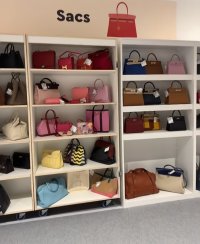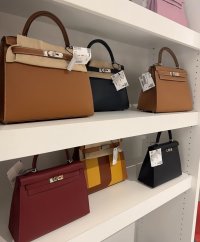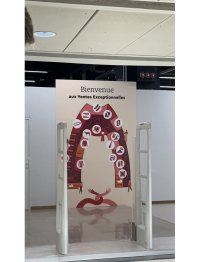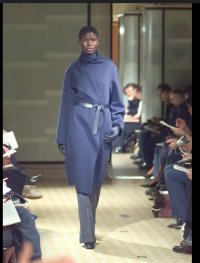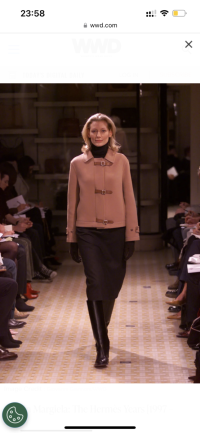You are using an out of date browser. It may not display this or other websites correctly.
You should upgrade or use an alternative browser.
You should upgrade or use an alternative browser.
Share interesting Hermès facts here!
- Thread starter needmoneyforbirkins
- Start date
TPF may earn a commission from merchant affiliate
links, including eBay, Amazon, and others
More options
Who Replied?Insane! Looks like 2290 for a Kelly sellier! Absolutely insane prices! I Will take one of each, please!Hermes ventes exceptionnelle (staff only), they do have kelly and constance on sale for only selected members
View attachment 5812437View attachment 5812438View attachment 5812439
With what the SAs have to put up with, I think they deserve a Kelly. Each.
For free, and in the color of their own choosing!With what the SAs have to put up with, I think they deserve a Kelly. Each.
SAs can't buy, only management level can access bagsFor free, and in the color of their own choosing!
Most of my senior SAs are at management level.SAs can't buy, only management level can access bags
 And yes some do buy bags, one SM has a rather rare one.
And yes some do buy bags, one SM has a rather rare one.
I have already written a post about anomalies in stitching colours here and here in this thread, but it was suggested (thank you, PT!) that I also make a post about anomalies with resin colours. This will just be a more fleshed out version of my post in the I.D. thread.
For those unaware, resin colour is one of several factors to consider when trying to determine a leather colour. While most leather colours are paired with a single resin colour, there are three main cases* in which a leather colour can be associated with more than one resin colour:
Case 1— Re-Introduced Colours
Perhaps the most frequent case of resin differences between the same leather colour occurs when Hermès decides to completely change the resin for a colour that is being re-introduced/unrested. One recent example of this is the colour Menthe which used to have mid-brown resin back when it was released in 2011. For some reason, when Menthe was re-introduced around 2020, Hermès decided to switch the resin colour to black. There are numerous other examples like this— Celeste, Mimosa, Anémone, etc.
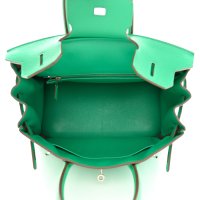

Pictured above: 2012 Menthe Clemence Birkin, brown resin (source: Fashionphile). 2020 Menthe Swift Berline Constance, black resin (source: Fashionphile).
Case 2— Different Leathers
The second case of this occurs when the disparity in resin colour is between different leathers. For instance, sometimes exotic bags will have a different resin colour than the regular leather versions of the same colour. One example of this is the colour Vert Anis which was popular in the early 2000s and came in a variety of regular and exotic leathers— Agneau, Chèvre Mysore, Clemence, Doblis**, Swift, Togo, Poro/Nilo Croc, Nilo Lizard, and Ostrich. While most of the regular leather offerings for this colour were released with brown resin, the exotic offerings came with black resin.
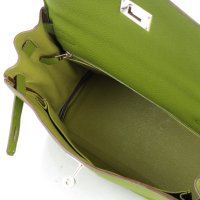
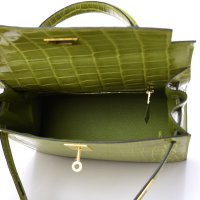
Pictured above: 2009 Vert Anis Clemence Kelly, brown resin (source: Fashionphile). 2012 Vert Anis Nilo Croc Kelly, black resin (source: Fashionphile).
Case 3— Contour Collection, c. 2015
The third case of this occurred from 2015-2017 with the limited edition Contour collection. In this collection, Birkins and Kellys were released in one of four combinations:

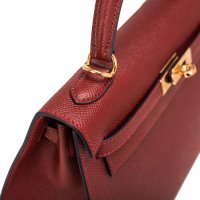

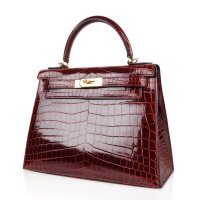
Pictured above: 1 (source: JaneFinds). 2 (source: World's Best). 3 (source: French Hunter). 4 (source: Mighty Chic).
*These are just three of the bigger examples I can think of, but of course there are several smaller examples too.
**As is custom, Doblis Suede bags come with no resin. Vert Anis Doblis was no exception to this rule.
For those unaware, resin colour is one of several factors to consider when trying to determine a leather colour. While most leather colours are paired with a single resin colour, there are three main cases* in which a leather colour can be associated with more than one resin colour:
Case 1— Re-Introduced Colours
Perhaps the most frequent case of resin differences between the same leather colour occurs when Hermès decides to completely change the resin for a colour that is being re-introduced/unrested. One recent example of this is the colour Menthe which used to have mid-brown resin back when it was released in 2011. For some reason, when Menthe was re-introduced around 2020, Hermès decided to switch the resin colour to black. There are numerous other examples like this— Celeste, Mimosa, Anémone, etc.


Pictured above: 2012 Menthe Clemence Birkin, brown resin (source: Fashionphile). 2020 Menthe Swift Berline Constance, black resin (source: Fashionphile).
Case 2— Different Leathers
The second case of this occurs when the disparity in resin colour is between different leathers. For instance, sometimes exotic bags will have a different resin colour than the regular leather versions of the same colour. One example of this is the colour Vert Anis which was popular in the early 2000s and came in a variety of regular and exotic leathers— Agneau, Chèvre Mysore, Clemence, Doblis**, Swift, Togo, Poro/Nilo Croc, Nilo Lizard, and Ostrich. While most of the regular leather offerings for this colour were released with brown resin, the exotic offerings came with black resin.


Pictured above: 2009 Vert Anis Clemence Kelly, brown resin (source: Fashionphile). 2012 Vert Anis Nilo Croc Kelly, black resin (source: Fashionphile).
Case 3— Contour Collection, c. 2015
The third case of this occurred from 2015-2017 with the limited edition Contour collection. In this collection, Birkins and Kellys were released in one of four combinations:
- Bleu Indigo Epsom with Rouge H resin
- Rouge H Epsom with Bleu Indigo/Navy resin
- Bleu Marine Poro Croc with Rouge H resin
- Bourgogne Nilo Croc with Bleu Indigo/Navy resin




Pictured above: 1 (source: JaneFinds). 2 (source: World's Best). 3 (source: French Hunter). 4 (source: Mighty Chic).
*These are just three of the bigger examples I can think of, but of course there are several smaller examples too.
**As is custom, Doblis Suede bags come with no resin. Vert Anis Doblis was no exception to this rule.
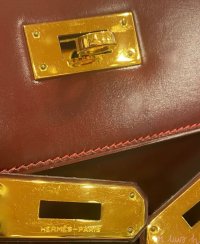
I already posted about this in the Reference Section, but thought I would post here too. No, the picture above is not reversed. Engraving can usually be found on the right sangle, but on vintage bags (especially pre-1985), it is not uncommon to find engraving on the left, right, or even both sangles in some cases. Here, it is on the left sangle of one of my oldest bags. And by the way, this is the original gold plated brass hardware that Hermès used before adopting the gold hallmark stamp on all GHW.

That's really helpful .My vintage 1959 box Kelly has onboth sangles .View attachment 5882533
I already posted about this in the Reference Section, but thought I would post here too. No, the picture above is not reversed. Engraving can usually be found on the right sangle, but on vintage bags (especially pre-1985), it is not uncommon to find engraving on the left, right, or even both sangles in some cases. Here, it is on the left sangle of one of my oldest bags. And by the way, this is the original gold plated brass hardware that Hermès used before adopting the gold hallmark stamp on all GHW.
So neat! You are the owner of a very rare bag!That's really helpful .My vintage 1959 box Kelly has onboth sangles .

My favourite era tbh.In 1997 Martin Margiela was appointed as a creative director of Hermès. Many people know about Jean Paul Gaultier era but not about the Margiela time. The fabrics, the silhouettes and the styling of the runways are simply impeccable.View attachment 5894196View attachment 5894197View attachment 5894198View attachment 5894199
The definition of 'quiet luxury'
The first pic, swoon! That coat is stunning!!!My favourite era tbh.
The definition of 'quiet luxury'
Agreed! It's so classically sophisticated. Well-made and clearly pricey but not obviously "designer." I love it.My favourite era tbh.
The definition of 'quiet luxury'
I am so fascinated with all of your knowledge. Thank you so much.I have mentioned this in the previous pages but if you look at a certain angle, you can see that there is a sort of a grid pattern on on this togo:
View attachment 5580513
On the other hand, the article I mentioned says:
"Once dyed, the leather is now run through machines that have large, metal plates. The plates are etched in reverse with the pebble pattern. This is so when they pass the pattern into a material, it will look as desired. Think of this like the dies used to make coins, they’re cut in reverse, so when they strike the metal, a properly-oriented coin surface comes out.
The pebbled pattern is a textured, rounded, random design. The plates, with tremendous force, are then pressed into the leather, leaving its permanent shape in the material."
So it's also possible that the plates that the tannery is using for pressing the leathers are randomized itself, i.e. without the grid pattern that can be seen above.
Togo is a pebble-grained leather, and by definition, all pebble-grained leathers are pressed to get the grains.
Register on TPF! This sidebar then disappears and there are less ads!

